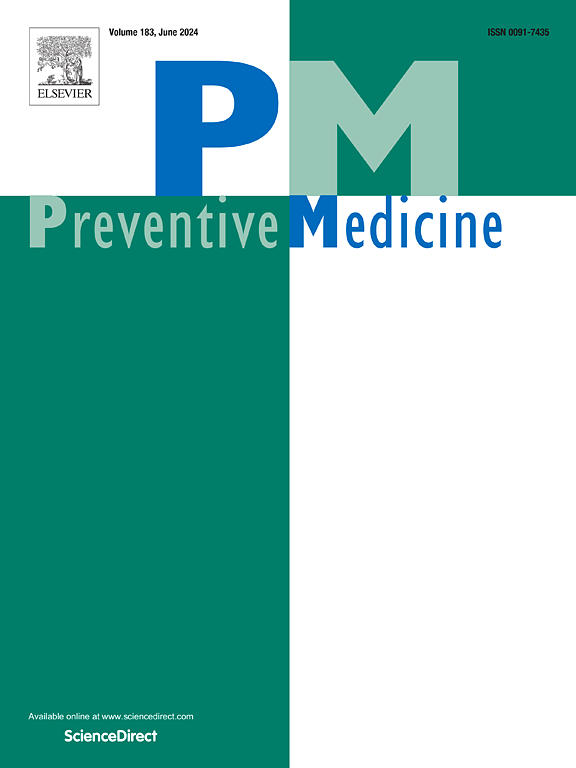Firearm violence victimization among youth and young adults: A socio-ecological analysis of risk and protective factors
IF 3.2
2区 医学
Q1 MEDICINE, GENERAL & INTERNAL
引用次数: 0
Abstract
Objective
To examine individual, interpersonal, community/societal, and policy-level risk and protective factors associated with firearm violence victimization (FVV) among persons 10–34 years old, and to assess age group differences in these associations.
Methods
Participants (n = 5311) were drawn from the AmeriSpeak panel (September 2023–January 2024), a nationally representative United States sample. Data sources included online surveys, the U.S. Census, FBI crime reports, and a state firearm law database. Structural equation modeling assessed multi-level influences on FVV, incorporating firearm access, carrying, and attitudes (FACSA), prior victimization, and other social, policy, and demographic factors. Interaction terms were used to assess age differences (10–17 years old versus 18–34 years old).
Results
In the fully specified model, only two variables—FACSA and Juvenile Victimization, Perpetration, and Trauma History (JVPTH) —remained statistically significant predictors of FVV. Permissive firearm laws indirectly elevated FVV risk by increasing firearm exposure. Age-stratified interactions showed no statistically significant differences in predictors between youth and young adults. This suggests that FACSA and JVPTH risk factors operate similarly across developmental stages.
Conclusions
Firearm-related behaviors and early-life trauma are central drivers of FVV. These two factors accounted for the greatest risk when controlling for other influences. Policy Implications: Prevention strategies should integrate early-life trauma intervention, firearm behavior education, and structural reforms to prevent FVV. Also, violence interruption strategies targeted toward young persons with histories of victimization could help prevent FVV. Addressing upstream firearm access and trauma exposure is critical to reducing FVV risk across developmental stages.
青少年和青年中的枪支暴力受害:风险和保护因素的社会生态学分析
目的探讨10-34岁人群中与枪支暴力受害(FVV)相关的个体、人际、社区/社会和政策层面的风险和保护因素,并评估这些关联的年龄组差异。方法参与者(n = 5311)来自AmeriSpeak小组(2023年9月至2024年1月),这是一个具有全国代表性的美国样本。数据来源包括在线调查、美国人口普查、联邦调查局犯罪报告和一个州枪支法数据库。结构方程模型评估了对FVV的多层次影响,包括枪支获取、携带和态度(FACSA)、先前受害情况以及其他社会、政策和人口因素。相互作用项用于评估年龄差异(10-17岁vs 18-34岁)。结果在完全指定的模型中,只有两个变量facsa和青少年受害、犯罪和创伤史(JVPTH)仍然是FVV的统计显著预测因子。宽松的枪支法律通过增加枪支暴露间接增加了FVV风险。年龄分层的相互作用在青少年和年轻人之间的预测因子没有统计学上的显著差异。这表明FACSA和JVPTH风险因素在发育阶段的作用相似。结论枪械相关行为和早期生活创伤是FVV的主要驱动因素。在控制其他影响的情况下,这两个因素造成的风险最大。政策启示:预防策略应结合生命早期创伤干预、枪支行为教育和结构改革来预防FVV。此外,针对有受害史的年轻人的暴力中断战略可以帮助预防FVV。解决上游枪支获取和创伤暴露问题对于降低整个发育阶段的FVV风险至关重要。
本文章由计算机程序翻译,如有差异,请以英文原文为准。
求助全文
约1分钟内获得全文
求助全文
来源期刊

Preventive medicine
医学-公共卫生、环境卫生与职业卫生
CiteScore
7.70
自引率
3.90%
发文量
0
审稿时长
42 days
期刊介绍:
Founded in 1972 by Ernst Wynder, Preventive Medicine is an international scholarly journal that provides prompt publication of original articles on the science and practice of disease prevention, health promotion, and public health policymaking. Preventive Medicine aims to reward innovation. It will favor insightful observational studies, thoughtful explorations of health data, unsuspected new angles for existing hypotheses, robust randomized controlled trials, and impartial systematic reviews. Preventive Medicine''s ultimate goal is to publish research that will have an impact on the work of practitioners of disease prevention and health promotion, as well as of related disciplines.
 求助内容:
求助内容: 应助结果提醒方式:
应助结果提醒方式:


